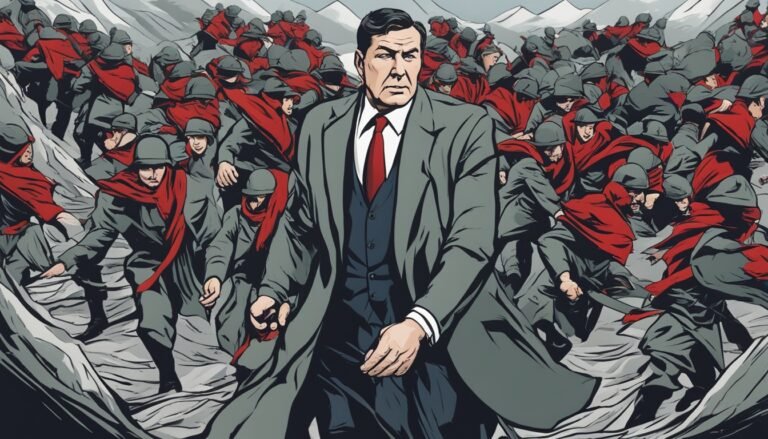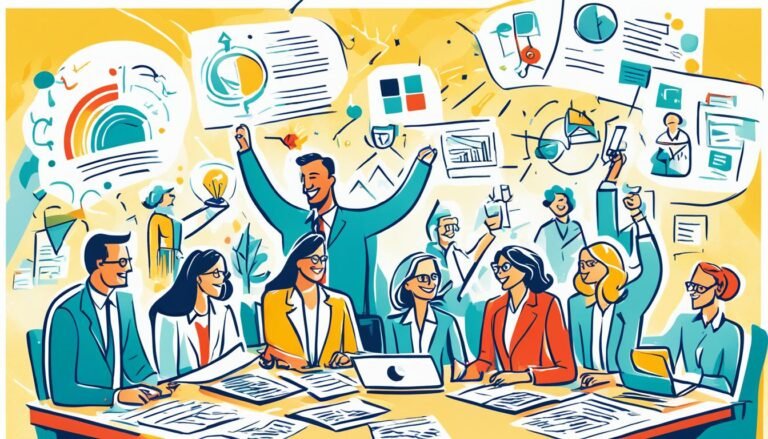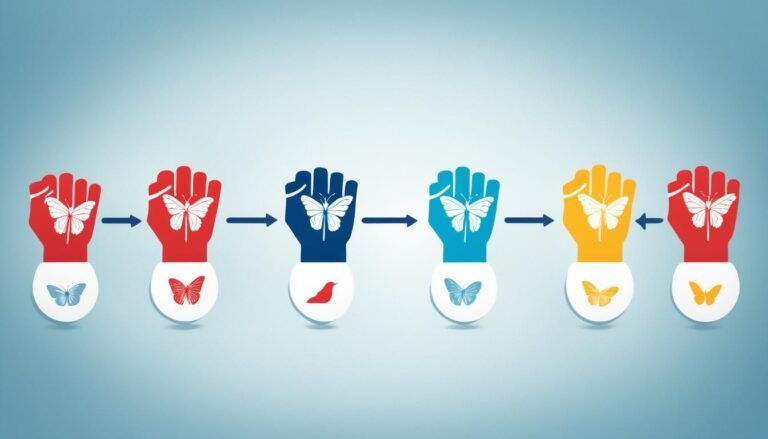Leadership Decision-Making: Making Smart Choices
“The best way to predict your future is to create it.” – Peter Drucker
Being a strong leader means making wise choices. This is a key part of leadership. Leaders greatly influence success in their groups. They use their skills and thinking to make the best decisions.
These choices affect the organization’s money, how happy the workers are, and if customers are pleased. Good leaders get the facts, think things over, and talk to experts. They look at all the options, weigh the good and bad, and think about the outcomes.
Key Takeaways:
- Making smart choices is crucial for leading effectively.
- Leaders greatly influence different parts of the organization by their decisions.
- Smart leaders collect data, analyze it, and seek advice to choose wisely.
- Knowing the possible outcomes of decisions is key in making them well.
- Leaders examine all choices, consider the pros and cons, and choose after careful thought.
The Importance of Decision-Making in Leadership
Decision-making is key in leadership. Leaders choose the way forward for their team. Every decision affects the organization in a big way.
Great leaders make choices based on facts, not just feelings. They research, look at data, and talk with experts. This helps them make decisions that are right for their organization’s goals.
Deciding well means looking at all sides. Leaders need to think about what might go wrong, what is gained, and what will follow each choice.
For leaders, making good decisions is vital. It leads to their organization’s success and lasting strength. With the right choices, leaders bring their teams to grow and thrive.
Leaders don’t follow one rule to make decisions. They use different methods, like thinking logically or trusting their instincts. The best way depends on what the organization needs and stands for.
An ideal decision-making process in leadership involves certain steps:
- Collecting important info and data
- Finding various options
- Weighing the good and bad of each option
- Thinking about the possible outcomes and risks
- Getting thoughts and ideas from others
- Deciding after careful thought
- Putting the decision into action and reviewing its effects
This process helps leaders make choices that lead to success. Their decisions have a positive effect on the group and everyone involved.
The image above shows how complex decision-making in leadership can be. It’s a map of the many steps and things leaders need to consider when deciding.
The Art of Delegation in Decision-Making
Leadership is balanced on the art of delegation. Good leaders know how to share the load wisely. This approach minimizes stress and maximizes team efficiency by delegating decision-making.
Delegation is strategic, not just about spreading the work. It’s choosing what to give to others so you can focus on more important things. This method optimizes your time and improves decision outcomes.
When leaders let their team members make decisions, it shows trust. Team members feel their work matters, leading to better outcomes and a happier team.
Opening up decisions to the team brings in fresh ideas. It also helps team members grow by giving them more responsibility. This boosts their skills and makes them more valuable to the team.
“Effective delegation is not about abdicating responsibility, but rather about empowering others to make well-informed choices within their areas of expertise.” – Jane Smith, Leadership Expert
By passing simple decisions to the team, leaders free themselves to focus on the big picture. This is crucial for the organization’s success and their own growth as leaders.
Handing over decisions to the team builds trust and a positive work culture. It makes team members feel valued, boosting their happiness and the organization’s achievements.
Effective Delegation in Action
Let’s see delegation at work with a simple example:
| Leadership Decision | Delegated Decision |
|---|---|
| Determining the company’s long-term strategic goals | Setting department-level objectives aligned with the company’s goals |
| Designing the overall marketing strategy | Deciding on the social media advertising strategy |
| Approving the annual budget | Deciding on individual department budgets |
This example shows how delegation helps leaders wisely share decisions. By doing so, they ensure the best use of their team’s skills and time.
Delegation, when done right, is a key leadership skill. It combines the power of collective thinking with smart decision-making, leading teams to success.
Effective Decision-Making Strategies for Leaders
Being a good leader means making choices that help a group succeed. To do this, leaders need to follow smart strategies when making decisions. This helps them think better and pick the choices that lead to good results.
Defining Clear Objectives and Goals
Effective decision-making strategies start by knowing clearly what you want to achieve. If goals are fuzzy, leaders might make choices that don’t fit the group’s main mission. Having a clear idea helps make decisions that move the group closer to success.
Gathering Relevant Information
Before choosing, leaders gather all needed info. This can mean looking at market trends, asking team members for thoughts, or getting advice from experts. With lots of details, decisions are based on facts rather than guesses.
Evaluating Multiple Alternatives
Leadership decision-making techniques include looking at many options. Leaders weigh the pros and cons of each possibility against the overall mission and aims. This helps them find the choice that best meets the group’s objectives.
Anticipating Potential Consequences
Leaders should think about the possible results of their decisions. By looking ahead, they can see how choices might affect the finances, team spirit, or customer happiness. This foresight lets them pick options that lower risk and boost rewards.
Implementing and Reviewing Decisions
After making a decision, leaders must put it into action well. This might mean assigning tasks, setting up budgets, and checking on progress. Also, it’s important to review decisions regularly and tweak them if needed based on new info or changes.
By using these effective strategies, leaders can choose wisely and guide their groups to success. These methods give a clear path for deciding, helping leaders face issues, grab chances, and reach their objectives.
Prioritizing Decisions and Managing Decision Fatigue
As leaders, we face a lot of choices every day. It’s important to pick which decisions need our focus. This way, we can spend our time and effort on the most vital choices. This ensures we think carefully and choose wisely.
One good way to do this is by putting decisions into groups based on importance. Small decisions can become part of our daily routine. But, big decisions need more thought and time. By making routines for small decisions, like planning our day ahead or setting tasks on autopilot, we save brainpower. This then goes into solving the larger, more complex decisions.
Good leaders know how to handle decision weariness. They leave the small choices for later, at the end of the day. This is when we are most tired. For the big choices, they dive in during the morning, taking advantage of fresh minds. This helps leaders think clearly. It makes their important decisions well-thought-out and focused.
Our feelings play a big part in making decisions clear. These feelings can sometimes mislead us, causing us to make decisions we might regret. To think clearly, we need to notice our emotions. We then try to make decisions using logical and clear-headed thinking.
Taking time, like sleeping on it, can also help cut down on decision weariness. It lets our minds work through information and see things more clearly. But, taking too much time can backfire. It might cause us to get stuck in overthinking. The key is to find a good balance between thinking it over and making a choice.
Exercise and Seeking Outside Counsel
To improve our decision-making, there are other helpful strategies. For instance, regular exercise can lower stress and boost our ability to think clearly. It’s a great way to support better decisions.
Getting advice from others is also a smart move. It lets us see different sides of a decision. This means talking with experts or trusted friends. They can offer new insights. This can help us make decisions that are more thought-out.
Good leaders know the value of ethics in making decisions. They aim to line up their choices with their moral values. This helps them stand for integrity and lead responsibly.
Taking time to reflect is also key to better decision-making. Looking back on our choices, success, and mistakes is informative. It teaches us to make smarter decisions in the future.
To sum up, selecting what to focus on and handling decision weariness well are key in leading effectively. By managing our mental effort, keeping emotions in check, and using tools like routines, we can lead wisely. Seeking advice from others also guides us towards making decisions that help our organizations grow.
Using Exercise and Seeking Outside Counsel in Decision-Making
Adding exercise to your routine can improve decision-making. Just 30 minutes of exercise can lower stress and boost clear thinking. This helps you make better choices.
“Exercise is great not only for your body. It also makes your brain sharper, improving how you make decisions.”
Getting advice from others is also key. Talking to people you trust or experts can help. It lets you see different points of view and spot mistakes you might have missed.
Top leaders rely on their values when they make big decisions. This keeps their choices in line with their goals. They also review past decisions to learn from them. This helps improve their decision-making over time.
Exercising and talking to others can widen your views. It helps cut down on mistakes in your decisions. These steps help in personal growth too.
The Role of Routines and Morning Productivity in Decision-Making
Successful leaders use routines to make better decisions. They turn small decisions into habits to save time. This way, they can focus on big choices without getting tired.
Think of decision-making like a muscle. It can tire out during the day. Routines help leaders avoid making the same choices. This saves their brain power for important decisions. These habits might include picking out clothes or planning breakfast.
Morning is the best time to make tough decisions. Our minds are clear and alert then. Using this time for hard tasks leads to better results.
Getting ready the night before also helps. By setting up tasks ahead of time, leaders can start the day strong. This approach cuts down on stress and makes decision-making smoother.
A morning routine checklist is great too:
- Prepare a to-do list the night before
- Set clear priorities and goals for the day
- Engage in a morning exercise routine
- Meditate or practice mindfulness to center the mind
- Stay hydrated and nourished with a balanced breakfast
“The secret of your success is determined by your daily agenda.” – John C. Maxwell
Leaders who use routines and morning time wisely can think clearer. They make smarter decisions, helping their teams and themselves. These simple steps lead to better choices and more success.
| Routine | Benefits |
|---|---|
| Morning exercise | Improves mental clarity and reduces stress |
| Planning the night before | Provides a clear agenda and reduces decision fatigue |
| Meditation or mindfulness practice | Enhances focus and aids in objective decision-making |
| Balanced breakfast | Supports optimal brain function and energy levels |
Emotional Intelligence and Objective Evaluation in Decision-Making
Emotional intelligence is key for leaders to make good decisions. It helps them understand how their feelings affect their actions. This understanding lets leaders set feelings aside when examining choices. They look at evidence and values to make the best decision.
Leaders use both their feelings and logic to evaluate choices. They combine understanding of their emotions with looking at the facts. This leads to a better understanding of the possible results of their decisions.
When making choices, leaders must think about both now and the future. They analyze risks and rewards, plus how choices fit their group’s goals. By doing this, they get a well-rounded view, considering both facts and feelings.
Leaders who focus on clear thinking and emotional awareness tend to do well. It’s important for a leader to control their feelings. They should use them as a guide in making rational decisions. This way, leaders can improve their decision-making and help their organization succeed.

Reflection and Timely Decision-Making
Exploring past decisions helps leaders become better at making future ones. Mark Twain said, “Good choices come from experience, but experience comes from bad choices.” This means learning from mistakes is very important. By looking back and learning from errors, leaders can spot trends and make smarter decisions ahead.
Still, just thinking about the past isn’t the full answer. It’s also key to act at the right time. Thinking too much can freeze you, stopping action and progress. To stay ahead, leaders must decide when to act on their thoughts.
“The key to successful decision-making lies in finding the right balance between reflection and action.”
When leaders face big decisions, they collect facts, do their research, and think carefully. They also get advice from people they trust. This all helps them feel more sure about their choices.
Benefits of Reflection in Decision-Making
Thinking back before deciding has some big benefits:
- It makes you know yourself better, so you can make smarter choices.
- It sharpens your mind to make good decisions by learning from the past.
- It makes you wise, learning from both success and failure.
- It makes you better at solving problems in new and creative ways.
The Importance of Timely Decision-Making
Making choices soon is very important for a few reasons:
- It helps you catch good chances before they go away.
- It keeps your business or team ready for anything new that comes.
- It makes everyone trust in your leadership more.
- It uses resources wisely, making things work better and saving money.
Being good at both reflecting and deciding quickly makes leaders and their teams do better. It leads to great results for everyone involved.
Below, we’ll show how acting fast impacts different industries with this table:
| Industry | Effect of Timely Decision-Making |
|---|---|
| Technology | Allows for faster product development and keeps up with rapidly changing market demands. |
| Finance | Enables quick responses to market fluctuations, minimizing financial risks and maximizing returns. |
| Healthcare | Saves lives by ensuring timely treatments, diagnoses, and allocation of resources in critical situations. |
| Retail | Helps meet customer demands, capitalize on emerging trends, and stay ahead of competitors. |
| Manufacturing | Increases operational efficiency, reduces downtime, and streamlines production processes. |
Conclusion
Leadership decision-making is a skill that can get better with practice. Good leaders know the importance of making wise choices. They see how their decisions influence their group’s success.
To make the right choices, leaders use many strategies. They first set clear goals and objectives. Then, they collect important facts and look at different ways to move forward. It’s vital for leaders to think about what might happen next because of their choices. They should also check and change their decisions as needed to keep on the right path.
With the right methods, leaders can make smarter decisions. They become better at handling tough problems and reaching their aims. Their organizations benefit from their strong decision-making. Learning to decide well never stops. It’s a skill that grows as leaders face new situations.
FAQ
What is the importance of decision-making in leadership?
Decision-making is key for leaders. It shapes the path and success of a group. Leaders must choose wisely to match the organization’s aims.
How does delegation play a role in decision-making in leadership?
Delegation helps leaders make the most of their team. They can assign some decisions to team members. This way, leaders focus on big strategy decisions.
What are effective decision-making strategies for leaders?
Leaders use several steps to make effective decisions. They set clear goals, get info, look at options, think about outcomes, and then act. Afterward, they review their choices.
How should leaders prioritize decisions and manage decision fatigue?
Leaders should turn daily decisions into habits. They can save hard decisions for the morning. This way, they face complex choices first thing when their minds are sharpest.
How can exercise and seeking outside counsel aid decision-making in leadership?
Working out lowers stress and sharpens the mind. Talking to others outside your team offers fresh views. It helps avoid personal bias in decisions.
What is the role of routines and morning productivity in decision-making?
Set routines handle small choices without thinking. This saves brainpower for crucial decisions. Mornings are the best for big decisions, leading to better results.
How does emotional intelligence and objective evaluation impact decision-making?
Emotional smarts help leaders decide more clearly. Looking at the pros and cons, values, and possible regrets is key. This makes decisions more balanced.
How does reflection and timely decision-making contribute to effective leadership decision-making?
Thinking about past decisions teaches leaders. It helps them get better. Making choices on time, with deadlines, is crucial. It keeps the team moving forward.
What is the importance of leadership decision-making in making smart choices?
Leadership decisions are at the core of success. Good decision-making skills let leaders face problems and grab chances. It is essential for reaching the group’s goals.








